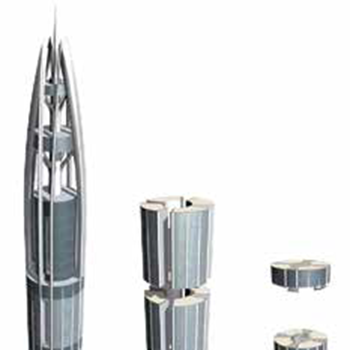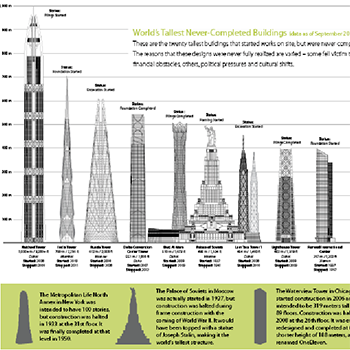Filter by
You must be a CTBUH Member to view this resource.
Nakheel Tower
Building
Never Completed
residential / hotel / office
steel/concrete
LEED Silver BD+C: Core and Shell
1,000.0+ m / 3,281+ ft
200
156
900,000 m² / 9,687,519 ft²
Usually involved in the front end design, with a "typical" condition being that of a leadership role through either Schematic Design or Design Development, and then a monitoring role through the CD and CA phases.
The Design Engineer is usually involved in the front end design, typically taking the leadership role in the Schematic Design and Design Development, and then a monitoring role through the CD and CA phases.
The Engineer of Record takes the balance of the engineering effort not executed by the “Design Engineer,” typically responsible for construction documents, conforming to local codes, etc.
Other Consultant refers to other organizations which provided significant consultation services for a building project (e.g. wind consultants, environmental consultants, fire and life safety consultants, etc).
You must be a CTBUH Member to view this resource.
Usually involved in the front end design, with a "typical" condition being that of a leadership role through either Schematic Design or Design Development, and then a monitoring role through the CD and CA phases.
The Design Engineer is usually involved in the front end design, typically taking the leadership role in the Schematic Design and Design Development, and then a monitoring role through the CD and CA phases.
The Engineer of Record takes the balance of the engineering effort not executed by the “Design Engineer,” typically responsible for construction documents, conforming to local codes, etc.
Other Consultant refers to other organizations which provided significant consultation services for a building project (e.g. wind consultants, environmental consultants, fire and life safety consultants, etc).
CTBUH Singapore: How to Improve Design and Build Efficiency
19 July 2016 - Event

05 February 2010 | Dubai
Improved Techniques for Vertical Transport for Supertall Buildings
This presentation covers the innovative techniques and applied technologies for the vertical transportation system for the 1-kilometre, 200+ storey high Nakheel Tower Dubai, which started...

28 December 2019
Tall Buildings of the Future as Seen From the Present
SawTeen See, Robert Bird Group Pty Ltd
Aerodynamic damping through the use of vertical long slots reduces the dynamic component of the wind loads on the building. Seminal examples include the three-legged...

05 February 2010 | Dubai
Improved Techniques for Vertical Transport for Supertall Buildings
This presentation covers the innovative techniques and applied technologies for the vertical transportation system for the 1-kilometre, 200+ storey high Nakheel Tower Dubai, which started...

23 October 2009 | Dubai
Mark Mitcheson-Low of Woods Bagot is interviewed by Jeff Herzer during the 2009 CTBUH Chicago Conference at Illinois Institute of Technology, Chicago. Mark talks about...

23 October 2009 | Dubai
Kilometer-High Tower: Fact or Fiction?
The Nakheel Harbor and Tower project was officially launched in October 2008 – as the world’s economy went into meltdown. Several years of significant work...

28 December 2019
Tall Buildings of the Future as Seen From the Present
Aerodynamic damping through the use of vertical long slots reduces the dynamic component of the wind loads on the building. Seminal examples include the three-legged...

26 October 2015
Risk-Based Approach of Achieving Code Compliance in Tall Buildings: Case Study
This paper is a case study of Nakheel Tower, Dubai, UAE – a proposed 1,000m and 200 plus story tall building – and the risk-based...

06 November 2014
Dream Deferred: Unfinished Tall Buildings
Without big dreams, there would be no tall buildings. Conceiving, financing, designing, and constructing a skyscraper is no simple feat, even under the best of...

07 August 2009
Case Study: Nakheel Tower - The Vertical City
Nakheel Harbour & Tower, Dubai's new capital, will be a beacon of inspiration for the region and the world, incorporating elements from Islamic culture. Encompassing...
Subscribe below to receive periodic updates from CTBUH on the latest Tall Building and Urban news and CTBUH initiatives, including our monthly newsletter. Fields with a red asterisk (*) next to them are required.
View our privacy policy